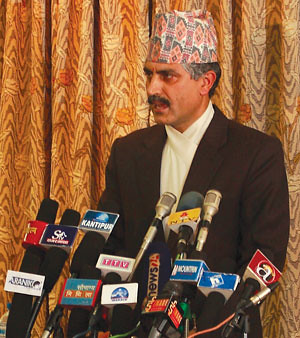
BIKRAM RAI
HERE WE GO AGAIN: Finance Minister Shankar Koirala announces the budget on Tuesday.
An annual budget that comes three times a year in three installments can only be an indication of Nepal’s badly stuttering economy. While the failure of the political leadership in the post-insurgency period has been disheartening, countries like Iraq and Afghanistan that are emerging from decades of devastating conflict have been posting impressive growth rates of over ten per cent and eight per cent respectively. Maybe it is time we looked around at our Asia neighbours learnt a few lessons.
Every budget is proclaimed as progressive, growth stimulating, and poor-centric, but every fiscal year we see a wide gap between what’s on paper and what actually happens on the ground. We spent only 26 per cent of our total budget in the last eight months. A typical sign of our lack of development, the Ministry for Social Welfare spent a measly 0.25 per cent of its allocated funds.
The partial budgets have arrived at a time of sluggish economy and also dampened whatever hopes ordinary Nepalis might have had from their government. In July and November 2012, the budget wasn’t on time and when it did it didn’t stimulate any growth and instead was used to cover general expense. As a result, the growth rate that dropped from 5.3 per cent to 4.2 last time has now nosedived to 3.65.
The fact that Nepal is an agricultural country is repeated so often, that it has become tiresome. But only 13 per cent of all agricultural produce finds any market. Farmers can’t even save three per cent of their incomes and thus have no possibility of improving returns from their occupation. Not surprisingly, growth in the agricultural sector has fallen from five per cent to one in the last seven months.
In the last eight months of the current fiscal year, our trade deficit has already topped last year’s total. Currently import volume is eight times all exports and exports to India even shrunk to a quarter of last year’s total.
Some friends in the government and the private sector have been chanting mantras of double digit growth. Even if we are able to generate massive progress by investing Rs 700 billion (the current budget is Rs 400 billion), our track record suggests we will not be able to sustain such growth. From 1997 to 2003, GDP formed four per cent of the budget, from 2003 to 2008 it dropped to three and from 2010 to 2013 it hasn’t gone above 3.8 per cent.
Nepalis spend 88 per cent of their income and whatever little they save is not enough to reinvest into the economy. There is such a huge gulf between savings and investment that trying to bridge this gap through domestic products is nearly impossible.
In a country like ours, poverty is still the biggest challenge for citizens and government alike. Different local and international agencies have their own definitions and reports on poverty in Nepal, but despite the apparent decrease in the number of the poor severe inequalities still remain. Also it feels like our parties have forgotten what the revolution and movement was all for.
Those responsible for developing policies must admit one failure on their part. Their calculation that someone earning Rs 42 per day will be able to purchase 2,200 calories worth of food for themselves in one month is invalid because the government has not been able to address the poor man’s purchasing power vis-a-vis inflation and rising foreign exchange rates.
We are heading from unregulated and centralised economy to a decentralised and self-sustaining federal structure. Even now, the centre spends five times more than the local government and 32 per cent of Nepal’s districts earn only five per cent of their annual expenses. Our greatest challenge now is to figure out a way to make these regions capable of contributing to the entire economy.
Regardless of the size of the budget, we must invest and focus development in priority areas while keeping track of our performance so that planners of the future have detailed road map.